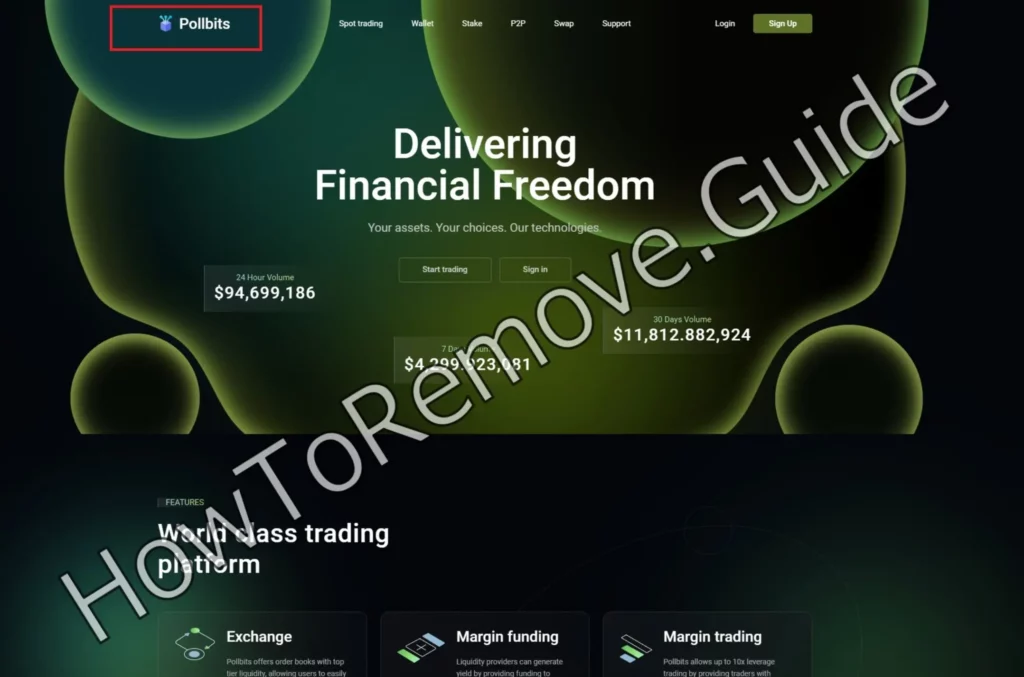To many people, especially those who aren’t sufficiently informed, cryptocurrency seems like this innovative new way to make quick money without investing too much time or resources. A miracle form of currency that just makes money out of thin air.
Obviously, this couldn’t be further from the truth, but the people behind scams like Pollbits (Pollbits.com) count on such common misconceptions to lure inexperienced users into throwing away their actual real money in hopes of huge returns that are never realized.
If you’ve come across Pollbits.com, or another similar site like Interholo or Ziceoc, do not engage with them! These sites are different flavors of the same cryptocurrency scam! Read the next lines if you want to inform yourself about how they lure you in and how to avoid them in the future.

What is the Pollbits Scam?
Pollbits is a textbook cryptocurrency scam site that uses a very effective chain of deception to get you to send it a couple of hundred dollars (USD) that you’ll probably never be able to get back.
The first link in the chain is a social media post. It’s from a fake profile of a famous person like Elon Musk or Donald Trump. The post promises a 0.31 Bitcoin (approximately $90K) to the first set number of users who click its link.
The post can be just text but lately, scammers have started using deepfakes of the impersonated person to make it seem more real.
If the victim clicks the link, they are rerouted to a Pollbits.com page, where they can see their BTC reward waiting to be claimed. There’s just one small condition – a transaction fee of much less (a couple of hundred in BTC).
At this point, the gist of the scam should be obvious. Anyone who pays, loses their “transaction fee” for good and they are also unable to claim the reward.
This is the basic mechanism of scams like Pollbits and although it’s not particularly complex, it’s highly effective due to a couple of reasons I’ll talk about in a bit.
What to Do If You’ve Fallen for the Pollbits.com Cryptocurrency Scam
Let’s say you’ve already taken the bait and paid the Pollbits transfer fee. In other words, you’ve been scammed so what now? I have to be honest here, the couple of hundred you sent is probably gone forever. I do recommend reporting the scam – some luck users do get their money back this way – but don’t hold your breath.
But with all that said, there are absolutely actions you MUST take even if you’ve inadvertently lost some money. You need to act quickly and secure your accounts or these couple of hundred you just lost could be the least of your problems! Here’s what you’ve got to do:
- First things first, reset your passwords. Immediately. Don’t put it off thinking, “I’ll deal with this later”—act now. Opt for passwords that are unique, complex, and not something like your pet’s name or your birthday.
- Next, secure your accounts with two-factor authentication (2FA). Yes, it’s an extra step, but it’s worth it. Think of it as locking the door and setting the alarm. Even if scammers somehow have your password, 2FA stops them cold.
- Don’t forget to report the scam. Your cryptocurrency exchange’s support team should be your first point of contact. Also, file a report with your national cybercrime agency. These reports matter more than you might think—they help build a trail that could prevent others from falling victim.
- Finally, watch your accounts like a hawk. Keep an eye out for unauthorized activity, and if you see anything suspicious, report it immediately. It’s tempting to think, “The damage is done, what else could go wrong?” But vigilance can save you from further trouble.
Tip: If this has happened to you, remember: scammers thrive on inaction. Every step you take towards securing your digital life is a step away from their reach.

Techniques Used by the Pollbits Scam
Now, let’s talk about what makes Pollbits and other similar scam sites so effective at luring users. There are several notable techniques used by crypto scammers that you need to be aware of so you can recognize them in the future:
- Scammers often impersonate trusted figures or institutions. Whether it’s a familiar face like Elon Musk or an email that looks like it’s from a well-known crypto exchange, their goal is to make you think, “This looks official.” And once that trust is established, they exploit it mercilessly.
- Then there’s the promise of guaranteed returns. No real investment can offer such guarantees, especially in cryptocurrency. But the scammers count on one thing: your desire for a shortcut to success. Let’s be real—who wouldn’t want a quick and easy win? That’s the bait, and for too many, it works.
- Phishing websites add another layer of danger. These fake platforms are nearly indistinguishable from legitimate ones, designed to steal your login details the moment you enter them. If you’ve ever thought, “This URL seems off,” trust that instinct and double-check the source.
- And finally, there’s the urgency—the fear of missing out (FOMO). Scammers frame their offers as limited-time deals, pushing you to act before you think. They’re counting on you saying, “I don’t want to miss out,” instead of asking, “Does this even make sense?”
What’s the Lesson Here?
Scammers play on emotions. Whether it’s trust, greed, or urgency, they know how to make you act impulsively. Recognizing these tactics is your first defense.
The Pollbits.com Bitcoin Scam Red Flags
Most scams have some pretty glaring red flags for those with the presence of mind to look for them. Pollbits is no exception here. If you know what to look for when you come across an intriguing offer on the Internet, you’ll quickly be able to recognize it as a scam:
- Let’s start with guaranteed returns. Cryptocurrency markets are volatile, and anyone who claims you’ll “triple your money in a week” is lying. Think about it: if it sounds too good to be true, it almost always is.
- Next, there’s the request for upfront fees. Legitimate platforms don’t ask for payments to access a reward. The moment someone demands money upfront, it’s time to walk away.
- Fake endorsements are another big giveaway. Just because you see a celebrity’s face doesn’t mean they’re involved. Always verify endorsements through official channels. Don’t assume, “If Elon’s in it, it must be legit.”
- Finally, unsolicited offers are almost always a scam. Real opportunities don’t show up in your inbox out of nowhere. If you didn’t ask for it, don’t trust it.
What to Do When You Suspect a Scam
The moment you sense something’s off, disengage. Don’t reply, don’t click, and definitely don’t share any personal details. Block the sender, delete the message, and report the account.
If it’s a website that seems sketchy, check the URL carefully. Scammers often use slight spelling errors or odd domains to trick you. Stick to verified platforms and apps.
Two-factor authentication isn’t just a suggestion—it’s a must. Adding this extra layer of security can stop scammers in their tracks, even if they’ve got your password.
Action Plan: Think of every suspicious link or message as a ticking time bomb. The less you interact, the safer you are.
Protecting Your Digital Assets
A strong defence begins with preparation. Run regular antivirus scans to detect malware that could be stealing your information. If you’re thinking, “I don’t need antivirus anymore,” think again. Cyber threats evolve constantly, and staying ahead of them is key.
Password strength is non-negotiable. Use combinations of letters, numbers, and symbols to make your credentials hard to crack. Better yet, use a password manager to keep everything organized and secure.
For serious crypto investors, hardware wallets are invaluable. These devices keep your private keys offline, shielding them from hackers. Think of them as a digital safe for your wealth.
And don’t ignore updates. Software vulnerabilities are like open doors for scammers. Regular updates close those doors and keep your accounts secure.
Final Thoughts
Cryptocurrency offers incredible opportunities, but it also comes with risks. Scams like Pollbits remind us that caution and knowledge are our greatest tools. The next time something feels too good to be true, pause and ask yourself, “Is this worth the risk?”
Stay alert, stay informed, and, most importantly, trust your instincts. Your digital assets are worth protecting, and with the right mindset, you can navigate this ever-changing landscape with confidence.

Leave a Reply